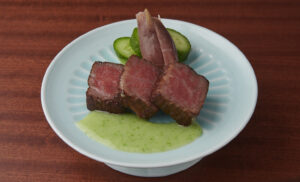Nigiri sushi, maki sushi and gunkan maki: these Sushi varieties are extremely well known in Japan and around the world. But there are also some varieties of sushi that are not so well known in the West. In Japan, they are often firmly associated with a particular region.
Sushi has changed again and again over the centuries. The historical forms have survived in part and are still known today as regional specialties.
Oshi sushi: sushi from the box
Oshi sushi consists of vinegar-soured rice and a topping, as you know it from nigiri. However, oshi sushi is immediately noticeable: The pieces of fish (mostly) and rice are exact rectangles. The loose appearance of nigiri sushi with the topping lying loosely on the rice is missing here.
The appearance of oshi sushi is due to the production. This requires a box, usually made of wood. Inside the box, the ingredients for the finished sushi are layered in upside-down order: First comes in the topping, which usually consists of fish fillets. On top of that, you put the soured sushi rice. Then the lid of the box is placed on the rice and pressed tightly.
Then you turn the box around. The pressed sushi detaches from the box and now lies as a solid block on the lid, which has become the base. The sushi master cuts the block into the finished sushi pieces.
Why is oshi sushi also called hako sushi?
Oshi sushi (押し寿司) is composed of the word oshi (押し, to press) and the word sushi 寿司. So it is quite obviously pressed sushi.
This form is also called hako sushi (箱寿司). So it's not so much about the special toppings or the shape of the sushi, but the way it's prepared.
Hako (箱) is the Japanese word for a box. This refers to the higher box in which the sushi was originally prepared - the designation has nothing to do with the block-like appearance
Where does oshi sushi come from?
It is now believed that oshi-sushi appeared in Ōsaka as early as during the Muromachi period (室町時代, 1336-1573). However, this is not historically verified. Sushi at that time consisted of fish, salt, and cooked rice. The ingredients were pressed in a wooden container to ferment them. Today, however, oshi sushi is prepared with vinegar-soured rice and is no longer fermented.
Until 1887, oshi sushi was prepared with inexpensive, popular fish. We know this for a fact because in that year the Yoshino Sushi Restaurant in Ōsaka changed the ingredients. They now started replacing the popular fish here with anago (アナゴ, saltwater eel, also known as conger), sea bream, Japanese shimagatsuo (シマガツオ) and various types of shrimp. Yoshino Sushi Restaurant was now selling high class hako sushi.
Keyword preparation: Hako sushi is time-consuming to prepare
Hako sushi or oshi sushi is very time consuming to prepare.
Because all ingredients must first be cooked and seasoned. This happens one by one to preserve and enhance the genuine flavor of each ingredient. Once prepared, this form of sushi retains its incomparable, excellent taste for a very long time. That is why hako sushi is so popular as a snack in the theater or as a gift.
Further development of Oshi Sushi: Battera Sushi
Battera sushi is also a type of pressed sushi.
This form developed in the Ōsaka of the middle Meiji period (明治時代, Japanese Meiji-jidai, 1868 - 1912). At that time, there were large quantities of fish from the herring family in Osaka Bay. Oshi sushi was invented to use this fish.
Battera sushi is now another name for this particular type of oshi sushi, which has its origin in the shape of the wooden molds for pressing. These were in fact adapted to the shape of the fish and looked roughly like a boat. The Portuguese word bateira (boat) was the inspiration for the name and shows to this day how strongly the trade between Osaka and Portugal had already increased in the Edo period.
Today, by the way, Battera sushi is usually prepared with mackerel.
Like other forms of oshi sushi, battera sushi is usually not served with soy sauce because the ingredients are already seasoned.
Funa sushi, the oldest form of nare sushi
Funa sushi (鮒寿司) is perhaps the oldest surviving form of nare sushi. Nare sushi (熟れ寿司) is fermented sushi. Today, funa sushi is considered one of the best dishes in Shiga Prefecture. Funa sushi is served to relatives at New Year. Linguistically, the name comes from fermentation: "Nare" means "matured".
This sushi is made by fermenting fish and seafood and eating it with this natural acid. Vinegar is completely omitted. There are two types of nare sushi. One type is made by stuffing salted fish with salted rice, and the other is made from slices of fish mixed with rice.
The production of Nare Sushi and therefore Funa Sushi takes several months. First, in the spring, the fish is scraped from the mouth. A special metal wire is used for this. The scraped fish is filled with salt, salted in a container also from the outside and weighted down with a weight. In summer, the salt is washed off with water, and rice is now placed in its place.
Funa sushi is enjoyed in thin slices. The ovaries of the fish, it is said, have a somewhat cheesy aroma. Overall, funa sushi has a strong acidity and smells pleasantly fermented.
Nare sushi: broader than funa sushi
Nare sushi consists of seafood and rice pressed under a heavy stone for a long period of time. Microorganisms ferment rice and seafood during this period. These are primarily lactobacteria, which break down proteins.
Nare sushi originally comes from China. But the production under the weight of a stone so exists only in Japan. In Japanese literature nare-sushi is mentioned already in the 8th century AD.
Edomae sushi: precursor of nigiri sushi
Edomae sushi is the precursor of today's nigiri sushi.
In the early 1800s, Hanaya Yohei invented nigiri sushi by combining rice vinegar with neta and adding wasabi. This nigiri sushi was still two to three times the size of today's sushi.
Hanaya Yohei's idea drew circles, and a rich nigiri tradition developed in Edo that lives on today - and is still being developed!
Edomae sushi shows three characteristics
First, fresh fish caught in Edo Bay is used. "Edomae" is simply the translation of "before Edo".
Edomae sushi and the style of this sushi has spread all over the world to this day - of course, not all restaurants use fish caught in Tōkyō Bay (formerly Edo).
Second, for edomae sushi, akasu (赤酢) is used.
Akasu is a rice vinegar that comes from sale production. Characteristic of Akasu is the stronger taste and richer aroma compared to normal rice vinegar. Nevertheless, Akasu is mild in its own unique way. Akasu replaces rice vinegar in Edomae sushi.
Third, neta are prepared in a whole range of different ways.
In the Edo period (1603 - 1868), transportation was still a major problem, especially for fresh ingredients that required refrigeration. Refrigerators and freezers did not yet exist. Even the freshest ingredients from the sea lost their freshness and quality when they had to be transported further. To cope with this, new methods of preparation were found to utilize ingredients from the sea while they were still fresh. The preparation methods provided a concentration of each ingredient's characteristic flavor and ensured that the animals from the sea stayed fresh longer. Marinades of salt or vinegar were just as common as steaming and stewing, as well as boiling the fish and shellfish and marinating them in special sauces.
Fish on vinegar-soured rice: that's nigiri sushi. And edomae sushi
Although edomae sushi appears to be confusingly similar to today's nigiri sushi, this form of sushi is found in very few, traditional restaurants.
Edomae sushi is considered a specialty, and the use of red akasu is truly essential. Authentic Edomae sushi is basically prepared with akasu. The mild seasoning of the red vinegar does not mask the delicate flavor of the fish, but enhances it.
Nigiri sushi today basically consists of placing high-quality, fresh fish on sushi rice and serving it. That's all that happens at first. Often the fish is not even the best quality, unless you go to a Japanese sushi restaurant.
With Edomae sushi, it doesn't stop there. Before the fish lands on the rice, it goes through a lengthy preparation. This is to bring out the very special flavor notes of each fish and emphasize its natural distinctiveness.
Example tuna: marinated and cooked
Known today primarily as toro and raw, the flesh of tuna is marinated in soy sauce and cooked for edomae sushi. Pre-cooked eel and white-fleshed fish such as flounder can also be prepared with kelp.
Frying or grilling is particularly suitable for very fatty, oily types of fish.
Edomae sushi brings together the strong flavors of akasu with prepared fish and seafood.






